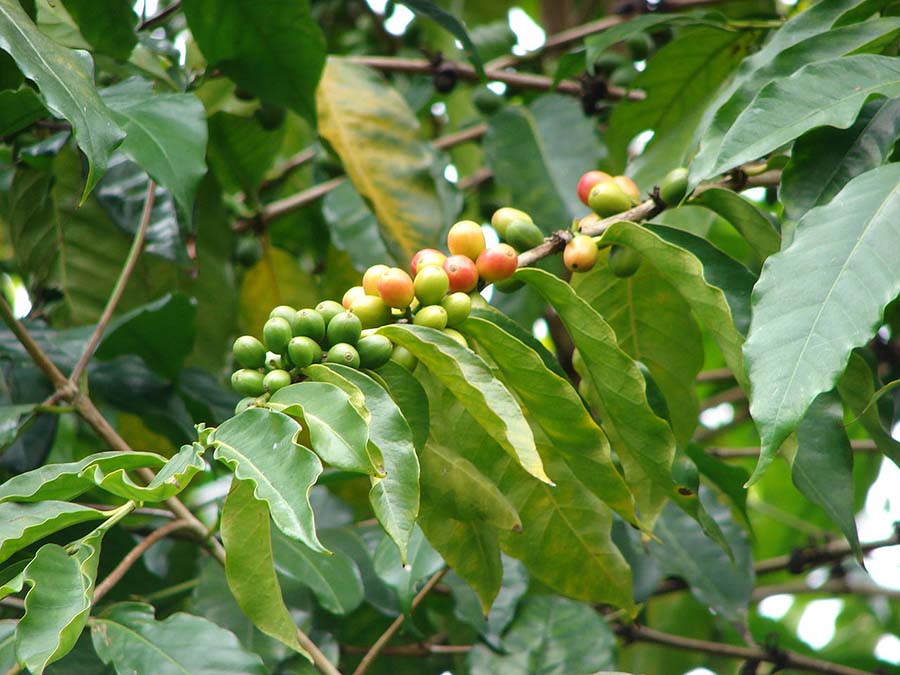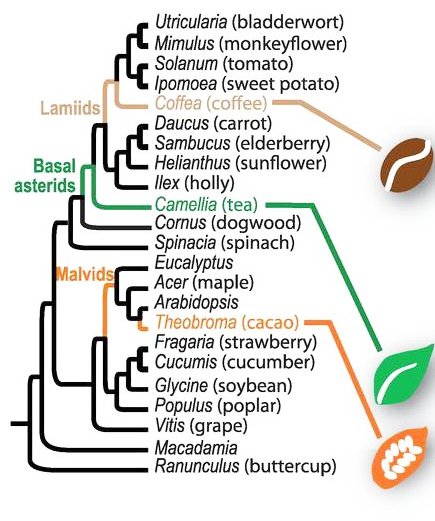Evolution of Caffeine Producing Plants

Engage: 85% of the U.S. population consumes at least one caffeinated beverage per day. Consider the beverages you’ve consumed in the last 3 days. How many were caffeinated? Do some have more caffeine than others? Where does caffeine come from?
The purine alkaloid compound caffeine that millions of people use each day to help them wake up and be productive has natural origins as a conserved core process. In many plants caffeine is synthesized through a complex chemical reaction that involves an enzyme called N-methyltransferases. These enzymes are found in all plants but some have evolved to produce a weapon called caffeine. This weapon prevents some organisms from eating the plant or returning to eat it once it has had a sample. In other cases, caffeine is added to nectar so that pollinators get an energy kick that allows them to forage longer2 (a benefit to the caffeine bearing plant).
Plants we are familiar with produce caffeine and we extract and enjoy it. Coffee is brewed from the seeds of various coffee plants including Arabica, tea from leaves of many plants of the Camellia genus, colas have caffeine (originally) from the Kola tree, Chocolate from the Cacao and Guarana seeds have twice the caffeine as coffee beans3.
Explore: Did all caffeine producing plants arise from a recent common ancestor, or did different plants converge on the process of caffeine synthesis?
Experimental Question: Is the pathway that uses N-methyltransferase a common, conserved process or have plants invented new ways using this enzyme to make caffeine? Basically, did evolution of caffeine synthesis happen once, or has it happened many times under the same (or similar) ecological pressures?
Process: You will focus on 3 plants that produce caffeine and use N-methyltransferase: coffee, tea and chocolate and compare their protein sequences to explore similarities and differences. .
Go to www.uniprot.org and search for caffeine synthase 1.
Check the boxes for Camellia sinensis, Coffea arabica, and Theobroma cacao. Save to your basket.
Go to your basket and check all 3 samples.
Click “Align” to compare the proteins for similarities. (This process make take a minute)
How to Read the Results - The letters represent individual amino acids in the sequences, with numbers indicating the location within the chain.
- An * (asterisk) indicates positions which have a single, fully conserved residue.
- A : (colon) indicates conservation between groups of strongly similar properties
- A . (period) indicates conservation between groups of weakly similar properties
1. In the left side menu, under “amino acid properties,” click similarity.
What do you notice when you do this? What is the difference between the dark gray areas and the light gray areas?
2. Scroll down and determine how many identical positions there are for the three compared plants: ____
What is the Identity: _______ % (The higher the percentage, the more similar the proteins are).
What general percentage would you expect if all 3 plants shared a recent common ancestor?.
3. Explain how these results help provide you with evidence to answer the experimental question?
Elaborate: In evolutionary biology, convergent evolution is the process where organisms not closely related, independently evolve similar traits as a result of having to adapt to similar environments or ecological niches.How is it possible that caffeine synthase could be in 3 separate plants but have very different amino acid sequences?
Read this abstract from PNAS: “Convergent Evolution of caffeine in Plants by co-option of exapted ancestral enzymes.” https://doi.org/10.1073/pnas.1602575113
Convergent evolution is a process that has occurred throughout the tree of life, but the historical genetic and biochemical context promoting the repeated independent origins of a trait is rarely understood. The well-known stimulant caffeine, and its xanthine alkaloid precursors, has evolved multiple times in flowering plant history for various roles in plant defense and pollination. We have shown that convergent caffeine production, surprisingly, has evolved by two previously unknown biochemical pathways in chocolate, citrus, and guaraná plants using caffeine synthase. Ancestral sequence resurrection reveals that this convergence was facilitated by co-option of genes maintained over 100 million y for alternative biochemical roles. The ancient enzymes of the Citrus lineage were exapted for reactions currently used for various steps of caffeine biosynthesis and required very few mutations to acquire modern-day enzymatic characteristics, allowing for the evolution of a complete pathway.
4. What additional clues does this text provide about the evolution of caffeine synthase? Consider the words “exaptation” and “convergent evolution” in your answer.
Evaluate: This phylogenetic tree shows the relatedness of several plant species. Caffeine producing plants are highlighted.
Source: : https://science.sciencemag.org/content/345/6201/1181.figures-only
5. Write a claim to answer the essential question. Use the search and phylogenetic tree as evidence to support or refute. Add reasoning statements to each piece of evidence explaining what your evidence shows in support or refutation of the essential question.




